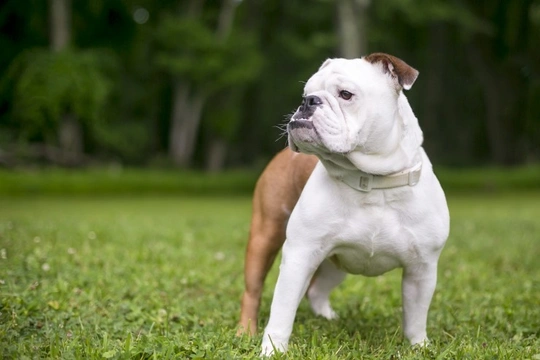
Why do dogs of some breeds have a pronounced underbite?
An underbite is the term we use to describe the conformation of a dog’s jaw and muzzle in which the lower jaw and so, teeth, protrude more than the upper set. This causes their bottom row of teeth to jut out further than the top row, which can often give the dog in question a somewhat grumpy or belligerent appearance, but which many owners find cute or quirky.
The normal conformation of the average dog’s jaw sees the top and bottom rows of teeth meeting evenly at the front in what is known as a scissor bite or normal bite, and an underbite is a conformation flaw – even though it is a fairly common and sometimes, accepted one within certain breeds.
In contrast to an underbite, the opposite presentation is called an overbite, and this means that the dog’s top row of teeth stick out more than their lower row, which is very different in appearance to an underbite but still very distinctive.
In this article we will examine why some dogs have an underbite, and look at some of the dog breeds within which individual members with an underbite are more common. We’ll also briefly discuss whether or not an underbite causes any problems for dogs, and what may be done about it.
Read on to find out why dogs of some breeds may have a pronounced underbite.
What causes an underbite in dogs?
There are a few different factors that can each result in an underbite, and this trait is most commonly associated with breeds that have brachycephalic faces, or a shorter-than-usual muzzle and so, less space for the dog’s features within it. Some brachycephalic dog breeds that often produce dogs with an underbite include the English bulldog, Pug, and Shih Tzu.
The shortened faces of brachycephalic dogs often result in a greater degree of shortening of the upper jaw compared to the lower one, and this limits the available space for the upper teeth to grow into, resulting in them growing and being pushed behind the lower set rather than meeting in a perfect scissor bite.
However, brachycephalic dogs are not the only type of dogs that may have an underbite, and an underbite can also develop as a result of the way the dog’s teeth grow in, or their positions in the jaw rather than the anatomy of the jaw bone itself.
This is particularly common in puppies that have retained milk teeth, or baby teeth that don’t fall out on their own to make room for their replacement set of adult teeth to descend from the jaw.
When the adult teeth are ready to descend into the spaces they should occupy, they will often loosen and push those retained baby teeth out of the way, and they will be lost in the normal manner. However, in some cases the baby teeth won’t move, and this interferes with the positions that the adult teeth descend to.
The adult teeth may grow in twisted or crooked, or grow in front of or behind the baby teeth that remain. The presence of two sets of teeth in the same space pushes some of those teeth forwards, resulting in an underbite of the teeth, even though the jaws themselves might otherwise have met evenly.
Normal puppy growth spurts can also result in an underbite in some cases, if the pup’s upper jaw grows and develops more slowly than their lower jaw. When this does occur, it can lead to some of the teeth in the dog’s upper jaw catching behind the teeth in the lower jaw, further restricting and limiting the normal growth of the upper jaw and stunting its development.
The vast majority of dogs with underbites developed their underbite due to their conformation or a predisposition to the type of conformation, growth issues and dental formation that can cause an underbite, but dogs may also acquire an underbite rather than being born with a propensity to having one.
Dogs that chew obsessively, that chew or eat things that are very tough or hard, or that chew in certain parts of their mouths rather than others may develop an underbite. Over time, chewing incorrectly, unevenly or in a strange position can cause the teeth themselves to slowly move and migrate, which may result in an underbite developing later on.
Is an underbite a problem for the dogs that exhibit it?
The physical appearance of a dog’s underbite can detract from their appearance and cause them to fall outside of their breed standard if the breed in question is one within which an underbite is considered to be a fault, but it does not always cause problems for the dog in question itself.
However, if the underbite is very pronounced, it can lead to uneven wear to the surfaces of the teeth that can lead to dental problems and loss of said teeth, and teeth that are crowded, gappy, uneven, crooked or twisted are also more prone to collecting food debris that can increase the risk of dental decay.
An underbite can also cause uneven wear to the jaw bones and hinges, and may make it difficult for the dog to eat comfortably, or even close their mouths.
Whilst most underbites cause few or no problems and this conformation issue can’t be corrected in terms of evening up the relative positions of the upper and lower jaw, crowded teeth, twisted teeth or retained teeth that are causing an underbite to develop may need to be removed in order to enable the dog to eat normally and without risk of causing further damage.



